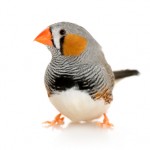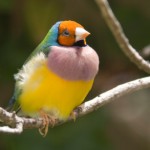What You Need to Know About Gouldian Finches
Gouldian finches are one of the most beautiful among finches and birds around the world. They’re multi-coloring makes them look very attractive and extremely breathtaking.
Also known as the Rainbow Finch or Painted Finch due to its many colors and patterns, the Gouldian Finch isn’t a very social creature…at least not to human beings. They are very social to their fellow finches and live more favorably in pairs or groups of pairs than singly. Gouldian finches do not like to be held or touched unlike other types of finches. If you are looking for a bird that you would like to pet or carry, this bird isn’t for you. They however sing very beautifully, the males in particular. Their chirping voice is one of the most beautiful among the finches.
These types of finches do not adapt well to environmental changes; for example, when you transfer them from a new place or change them from one cage to another. Stress lowers their resistance to disease and in turn may kill them.
Although originally coming from a tropical climate, it can with the proper knowledge, adapt to cold weather providing they are protected from the cold outside. Unlike any other type of finches, the gouldian finch does not have that soft down at the bottom of their feathers which help them insulate in the cold. When comfortable enough, they can start breeding.
A mature gouldian finch can weigh approximately 15 grams. A typical gouldian finch will have a neon blue neck, upper tail and rump, deep violet chest, yellow belly, and black pintail. Domestic gouldian finches have a variety of colors that are just as distinct but a little different.
The females and younglings have coloring that are much duller than their male counterparts, but are still very beautiful.
Originating from Australia, the Gouldian Finch is now endangered and threatened to extinction. There are few existing in the world and only 2,500 mature adults exist in the entire globe.
They were one of the most numerous birds in the entire world. One of the culprits for their decline in number is the destruction of their habitat from irresponsible land management and use. Perhaps another reason is because of their inability to adapt well to certain changes. In fact, they are the most difficult to take care of among the finches. Moving frequently from one environment to another quickly stresses them out making them less able to counter diseases; and they are particularly susceptible to infections in their respiratory system most especially in the wild.
They must have space free of excessive obstructions so they can fly. Their cage must not be smaller than 20×20x40 and you also must consider how many finches you have or plan to. The more there are the more space they need. They also must have sufficient sunlight or you can substitute it for a full spectrum fluorescent lighting. A balanced diet is essential and less or zero outside stimuli which may panic them. In the evening, it may be a good idea to keep the light on, especially in colder climates.
It is important, therefore, that owners do research these finches thoroughly before deciding to keep them as pets to help them survive.
Finch Cages – A Few Basic Reminders
Finches love to fly. So in case you have finches at home but don’t have space, means to build an aviary, or your collection of finches are too small, then it would be impractical to have an aviary built. However, you can opt for purchasing your finches a deceit sized cage.
If you like to breed finches, then all the more reason to have a few cages to keep two pairs in one cage to ensure they don’t mate with any other finch.
Your finch cages should be big enough to allow flight. Flying around in a spacious cage keeps them strong, active, healthy, and comfortable. Enough space for flight exercises their flight muscles. Just because it’s a cage and not an aviary, doesn’t mean its okay for the birds not to be able to fly. Two finches should at least have a cage that is 30 inches in length. And indeed, larger groups of finches need longer cages.
However, the size of your cages may also depend on the type of breed you own. Finches such as, Society, Zebra, and Gouldians are very active birds and a modestly sized cage will suffice. They can live comfortable lives in their cage and may even breed as long as all the other important factors, food and safety from predators comply.
Other breeds of finches that are slightly larger than the others; such as, the Tri-Color Nuns, Spice and Java Rice finches need a bigger cage. Other breeds such as, Waxbills are so active that they need an even more spacious cage.
Another thing to consider isn’t just the size of the cage but what you put inside it. It is important not to clutter the interior of the cage with too many toys, perches, swings, and what have you. Remember finches love to fly, and it won’t do them any good if there is too much stuff inside their cage barely allowing them room to fly. Make sure not to crowd perches or put them near each other. The birds will simply hop from one perch to the next without even actually flying. Try putting the perches on corners instead and nothing should be put in the way of their flight paths.
The bars of the cage should be spaced so that no bird can escape or have its head stuck between the spaces which can be deadly for them if no one is around to render aid.
Cages should be put at eye level and in a room that receives plenty of natural light – not direct sunlight, though. Drafts should be avoided since finches prefer dry environments. There should be soft light at night so they can see where they’re going to rest.
Also cages must be away from the reach of dogs, cats, and other household pets – even people. A room with too many people makes finches nervous. You might hear them sing but they may not be singing at all, they’re rather scared. So do allow space between where people walk and the cage.
How To Care For Your White Pet Finches
There are many animal creatures that are interesting to keep as pets, such as, dogs, fishes, birds, as well as many others. Talking about birds, white finches are the easiest birds to care and handle as pets. However, there are plenty of things to do in order for finches to be healthy like any other animal in your home. Relatively, finches are warm birds that bring happiness and joy to their owners when they are properly fed, housed, and cared for. However, there are some pointers that you should consider in handling pet finches.
• Take advice from reliable avian veterinarians. It’s not difficult to acquire birds like finches; however, there are many factors that you must take into consideration before taking a pet finch to your home as your new found pet. There are trustworthy avian veterinarians that you could contact and inquire about important information of your new bird. These people are very welcoming and open with their ideas and facts about birds. This consultation should be done as a prevention method so your pet finch does not get ill in the future. Avian veterinarians will be of great help in order to avoid and/or restore the health of the bird if any illness does take place.
• Secure a spacious cage for your pet bird. Despite the fact that finches are petite birds, there is a need to purchase a large cage so that your bird has a spacious area for them to perch on and fly at the same time. This feature will also give the birds a healthy environment to live in. Inside the spacious cage there should be an ample supply of food, natural tree rests, and water for the purpose of drinking and bathing. The area should also be convenient for quick clean up.
• Provide your white pet finches healthy foods. It is always good to see and observe your pet finches in their healthy state. That is why you must feed them a healthy food diet. These foods should include large white proso millets, canary seeds, and small yellow finch millets. It is necessary to soak the canary seeds in water for a brief period of time and place it in a small paper towel to allow the seeds to sprout. This process helps your pet finches sustain good health. A well balanced diet food recipe is: 1/2 parts of both canary seed sprouted and large white millet, and four parts of small yellow millet.
• Separate your white finches from the rest of the other finches. Since your finches have lived with you for sometime now, your birds might bully new acquired pet finches if they are placed in the same cage as the others. For this reason, it is best to separate your previous finches with your new ones. Try to have your new finches checked with a veterinarian and have them undergo quarantine for a period of time. This ensures that no illnesses will affect the rest of the finches if your new finches are harboring any sicknesses. If there are signs of poor health, have them cured as soon as possible so the illness does not get worse and harm the rest of your finches.
Your white pet finches’ look stunning when there nails are clean and cut because they have such a wonderful appearance and are pallid in color. The best treatment you can give your bird is by surrounding them in a good environment and giving them proper care. Doing this, you will have every bird lover envious of your finch family.
Zebra Finch Breeding
Zebra finch breeding is quite simple from making sure the environment is comfortable and safe enough for the birds, to their proper diet.
Both mother finch and father finch help in the nest process to make it comfortable and a temporary home for their younglings. The father finch will pick up pieces of string or grass and show them to the mother finch. She will carefully weave these materials into a concave comfortable enough for the eggs. Since your finches are caged, and cannot go out to look for materials to use in building their nest, you should provide them with materials such as, burlap and feathers. During this stage, don’t over-clean your cages or aviary; leave a few feathers since they can be used as a lining to make the nest soft and comfortable.
Once the nest is established, the female zebra finch is ready to incubate her eggs and hatch them. Eggs usually are laid once per day. After the last egg is laid, incubation begins. The female zebra finch incubates her eggs while the male zebra finch takes over every once in a while to give the female time to stretch, rest, eat, and drink.
The eggs will start hatching about thirteen days after incubation. Zebra finches can lay a maximum of eight eggs, but usually have 2 to 5 eggs in their nests.
When the eggs hatch it is time to feed your nesting finches with rearing / nestling food – a very crucial stage – which provides them with enough supplements. Other breeders feed their birds with rearing food before and after the eggs are laid.
Making your own nestling food may consist of a hard-boiled egg, fruits, and vegetables. Make sure the egg is completely cooked especially the yoke. Mash the entire egg: egg white, yolk, and shell. The shell is extremely loaded with calcium and the higher amounts of calcium the better.
After mashing the egg, mix pieces of finely chopped vegetables and fruits. Commonly used vegetables are parsley, broccoli, celery, turnip greens, and spinach. Acceptable fruits are bananas, oranges, apricots, apples, and grapes. Feed to the nesting birds several times per day but make sure to remove the egg if the birds do not immediately eat it since eggs spoil quickly.
Do not constantly handle the eggs to check if they are fertile or not. If there is any way that you can check on them without actually handling them, the better. Frequent handling may clog tiny pores in the shell where air goes through.
In 2 and ½ weeks, you should stop nest checking them so you do not startle the young birds and have them leave the nest early.
The birds will leave their nest for the first time when they are 3 weeks old and will feed themselves in about 4 weeks. At 5 – 6 weeks, the birds are well sufficient and may be removed from their parents’ cage into a separate one; soon after they will start to manifest characteristics that will enable you to distinguish male from female.
Always remember when zebra finch breeding, remove the nest after the birds start feeding on their own, unless, you want another clutch. It is advised, however, to limit your clutches to not more than 3 per year. If you want another clutch, it is absolutely necessary to remove the new self-feeding finches and transfer them to another cage, otherwise they may prompt their parents to chase them and pluck their feathers because they are interfering with the next clutch.
Finches Aviary
People particularly fond of finches that want to have their own finch aviary may build one at home. However, before actually building your aviary, there are a few things to consider including the safety of your birds and how you can minimize time and effort in maintenance.
One of the very first things to consider is the protection of your birds from other animals that might be a threat such as, cats, dogs, mice, rats, snakes, etc. This part is crucial not only because they endanger your pets but also because finches will never breed in mice infested areas. Having a footing made of concrete around the aviary’s perimeter will help solve this problem. In addition, metal sheets should be used as cladding all around the aviary by attaching them firmly to the concrete footing. A minimum height of 1 meter is important to prevent dangerous animals from climbing up into the aviary.
An important factor is the finches’ environment. They prefer warm and dry so it is best to maximize sunlight exposure and minimize windy and cool weather. Everything inside the aviary, including the floor, must be dry. Sands and gravel are ideal for the maintenance of a dry floor. Consider sub-drainage if your aviary is not fully roofed.
Plenty of people like to put plants inside. But bear in mind that having plants inside your aviary do not help in its maintenance of a warm and dry environment. Shaded areas are extremely prone to dampness. It is best therefore that the plants be sparse and to allow them plenty of room to grow inside the aviary. Too many plants may also mean more time spent cleaning. You don’t want to spend a lot of your time cleaning and scrubbing down bird droppings on plants. Same goes with plastic plants and decorations. Everything inside your aviary must be easy to clean.
Of course, there is the option of putting plants outside the aviary. But you have to arrange them in such a way that you do not compromise the birds’ safety. This is especially important for aviaries that have partial roofing. Make sure these plants aren’t tall enough for other animals to climb onto the metal sheets and into the aviary. Proper distance from the aviary is also crucial. Plants may attract mice, but if your aviary is well covered and protected and no small niches can be found for the mice to slip into, then all is well.
One of the advantages of having an aviary is that it is bigger than a bird cage and thus properly simulates the birds’ natural environment outside where they can roam and fly free. Perches must not be placed near each other to allow this natural activity (flying) to take place.
Installing a night light inside your finch aviary will help your finches see in the dark. Consider turning your lights on and off the same time each day and using a timer so you don’t forget to do this.
Finches for Sale
If you are a bird lover and are particularly looking to have a pet finch, you won’t have to worry because finches, along with other talking birds (like the parrots), singing birds and birds with colorful plumage, are among the most sought after pet birds in the world today. In other words, finches for sale aren’t exactly hard to find.
So where do you start looking?
There are various classifieds around the internet. Prices vary and may depend on the type of breeding.
However, finding finches for sale doesn’t have to mean buying from breeders only. It may mean trading or buying it from someone who just happens to have so many already that they are willing to sell them for an incredibly low price.
On the other hand, if you want to have a finch and at the same time want to save someone (a finch) by offering your home, then you may simply want to adopt, which is a cheaper alternative. Shelters usually take a history of the animals in their care and examine their health and behavior and takes note of them so you can find a perfect match.
Before buying, though, it is important that you take that extra step to getting to know the bird. You have to find out about its history, whether or not it has been sick before, or displayed unusual behavior. Then you take the extra step to see the bird for yourself.
Finches that are usually quiet or withdrawn and not active maybe ill because finches are not really the silent type. A finch that is responsive and alert is a healthy finch.
Also, finches don’t do well as single birds; in the wild they are found in pairs or in groups of pairs. So do take this fact into consideration and make sure that your finch has another finch bird(s) as a companion at your home.
The bird’s beak is also indicative of its health. An overgrown or crossed beak usually means poor health. It may be necessary to consult a person with some know-how so you know which size of beak is considered normal. Or you may bring this person with you in your finch ‘hunt’!
Also take a look at its nasal passages to ensure it does not have any mucus. Tattered feathers are considered normal and will cease after molting. A neat feather is another indication of good health.
It is also important to understand about the finch diet (they usually like small seeds as their beaks are more designed to crack them), behavior, and current/potential illnesses and make sure these factors fit your lifestyle and financial capability.
And although they sing (the males) particularly in mating activity, they interact very little with people. In fact, when they perceive a threat they are prone to panic attacks which may lead to their death for some of them.
Finding finches for sale isn’t all that hard if you have the right amount of money; mostly it is finding the right characteristics that will fit what you want from a finch pet. Good luck!
All about the Finches Nest
Finches are quite fun to watch. One of their fun activities that amuse lots of bird lovers is when they’re building their nests. The male finch goes out repeatedly to gather materials to build a nest for their babies. He comes back with these materials and shows them one by one to his partner, the female finch. The female finch inspects each one and selects which ones are good. Sometimes she drops the materials by accident and the male finch goes and picks them up. Then she slowly builds the nest, with the male finch assisting her or making the final touches… Now isn’t that adorable?
Finch nests in the wild may be made of such materials as cotton wool, animal hair, twigs, soft grass, course grass, plant and vegetable matter, moss, burlap / hessian, shrubs, and materials from trees. If you are breeding finches, you must provide your finches with materials in advance. Do not wait until they lay their eggs. It may compromise the health of the eggs or the parents may abandon their nests if they are partially made, hence endangering the younglings.
Instead, make sure to have nesting materials ready and make sure your finches have lots of choices to choose from by varying the material’s textures, shapes, and sizes. For instance, you can offer different textures by choosing different species of grass. Not all grass has the same texture so this is good. And then vary their size and length as well.
Variety is important so they can build strong yet comfortable nests. A mixture of choices is important so your finches can complete their nests. Partially made nests are usually due to not having enough materials readily available. Remember that a partially made nest is a not a good home for the younglings.
Feathers are extremely useful for finches. Leave a few feathers lying around so your finches can use them. Twigs of varying sizes and elasticity are also useful. Burlap / hessian are common choices and so is tissue. Household litter, flowers, and ferns are also good choices. Some birds may even use mud or spider webs in building their nest.
However, do not to take materials from the nests of wild birds. They may contain mites, parasites, and potentially pathogenic bacteria. Nests made by your own finches can be recycled and they have no apprehensions about that. Again, just remember not to bring anything that was once a part of another nest used by other birds from the outside.
If your finches are housed in an aviary with plants inside, your birds may build their nests on the branches of the plants there. If your aviary is the walk-in type, tread lightly because you might endanger their homes. Nest boxes or woven nests can be purchased in pet stores – finches will nest in these too. Some even make nests out of planter pots. If you want to try this avenue, make sure to secure it to a piece of wood or something that doesn’t easily budge and is stable.
Why Choose Finches as Pets
Why pet finches? You might hear yourself ask this question when somebody suggests you choose finches as pets. Well, there are a number of reasons and here they are…
First and foremost, finches come in a variety of amazingly beautiful colors; one example would be the Gouldian Finch. It is one of the most beautiful finches in the world because of their colors that seem to have come from a rainbow. On the other hand if you like plain colored birds, then the Zebra White Finch is just the finch for you. Aside from their color, finches have amazing vocal abilities. If you’re particularly fond of waking up to a chirping bird, then you’re in for a huge treat.
Finches come in different prices so you will always find one that fits your budget. Zebra finches for instance, are among the least expensive finches available in the market. They are also quite common so you don’t have to go to the ends of the Earth to get them.
Zebra finches are social birds to their fellow finches –quite naturally! Even if they are not particularly fond of human interaction, they might just get accustomed to you overtime. Regular feeding time is extremely important and may allow them to get used to you. Finches in general are sort of panicky (except Society Finches because they did not originate from the wild) so you have to establish regular feeding and cleaning schedules so you do not jeopardize their health.
Zebra finches originate from Australia and live in the open grasslands. You can create a more natural environment by adding plants that are bird-safe to your cage or aviary. You will make your finch sing with joy if you put organic grass in a pot inside their home.
A healthy and well-cared for Zebra Finch may live up to 10 years including seedling is their base diet. Supplements in the form of chopped hard-boiled eggs, fruits, and vegetables will also keep your finch friend in good health.
As stated above, Gouldian finches are one of the most beautifully colored birds in the world and may live 8-12 years. Take note that they are not social and should be kept in pairs or groups of pairs. Like most finches, they do not respond well to handling and are very prone to being stressed out as a result. They are also endangered, so before purchasing this type of finch, make sure you are able and committed to raising them.
Gouldian finches come from Australia where they live in eucalyptus forests. Like all other finches, they would greatly benefit from a roomy cage. Chopped boiled eggs, a standard finch mix, and some greens make a great food selection for Gouldian finches. But if you want them to be extremely healthy you might want to incorporate more fruits and vegetables into their diet… except for avocados. Avocados are said to be harmful to finches and other domestic animals such as, dogs and cats.
Society finches are another type of finch you may like to take home with you. Unlike the first two types of finches, Society finches are very social creatures. They do not exist in the wild and are a hybrid of two other finch species. Although more social compared to other finches, they must be kept in pairs or groups of pairs.
Their colors are extremely unique that not two finches are alike. They are not afraid of people but still take some time before they tolerate human contact such as, petting and eating food from human hands. These pet finches eat the same food as Gouldian and Zebra finches and live an average of 10 – 13 years.
Finch Biology
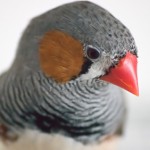
Male Zebra Finch
Finch biology is quite interesting especially when it comes to breeding or visually identifying females from males. Most people cannot tell the difference between a male from a female, no matter what type of bird it is. However, once you familiarize yourself with finches, identifying the female from male can be quite fun.
Generally, male finches have bright red beaks and female finches have orange beaks. Male feathers are more vivid in color whereas the females are duller or appear lighter in contrast to the male’s very vivid coloring. The males are the singers in the group and also use their song for courtship. At times they can often be heard practicing their number. Females do not possess the ability to sing but they often issue a warning or clicking sound when need be.
There are other ways to determine the sex of finches according to their type. For instance, male Zebra finches have bright red / dark orange beak, black breast bar, and orange cheeks. The females have orange beaks, and lack the color of the males except for the black feather on the chest area.
Some Zebra finches are completely white and can only be identified as male or female by the color of their beak. Their plain coloring is a result of a recessive mutation.
When it comes to Gouldian finches, you can identify them by looking at their beaks, the color of their breasts, or their overall coloring. Generally females are dull-colored in contrast to the males. In purple-breasted Gouldian finches, the females have a lighter shade of purple feathers on their breasts where as the males’ purple is more vivid and rich.
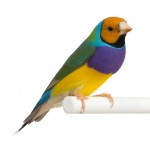
Male Gouldian Finch
Green singers, another type of finch, can be identified by their overall color. The males are brighter with more green especially in the chest area. The male green singers sing a lot. Overall, females look less green in contrast to the males. Females also have black spots around their neck making it look like a necklace.
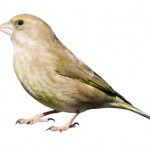
Female Green Finch
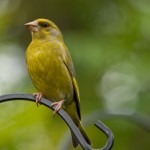
Male Green Finch
Other less common types of finches such as, the African Red Heads are easy to identify. Males are red-headed while females aren’t. However, finch biology can get difficult because other finches are very hard to identify, which may make breeding difficult. Finches like Orange Cheek Waxbills and Java Rice are hard to identify. Finches such as Society Finches, Spice Finches, Tri-Color Nuns, Lavender, and St. Helena Waxbills are quite impossible to visually determine between male or female. In this case you may consider visiting your avian veterinarian to aid you in identifying them. This is extremely important if you want to breed because you might be pairing birds that are two females or males if you don’t seek a veterinarian’s or other breeder’s advice.
Bear in mind, that in the finch world, the males are the best singers. You can observe who is male and female by observing your birds and taking note of those who have vocal prowess from those who don’t. You may identify them by putting tags and researching more about their types.
Finches that are easy to identify are the ones earlier mentioned: Zebra finches, Gouldian finches and green singing finches.
Tips for the New Zebra Finch Breeder
Becoming a finch breeder requires that you have some knowledge about finch breeding, their habits, and their behavior.
If you want to make a profit or extra income out of breeding finches, it may not be possible unless you have a sufficient number of birds and potential customers for your young-lings. When you have your young-lings, selling them right away to save on money that would otherwise be spent on bird food, is a realistic enough goal. This is especially true if you have only one or two pairs of breeding finches.
Zebra finches are particularly easy to breed. That is why they are among the most common finches out there. If you are a first time breeder, choosing these birds would be a wise choice. They can even breed in unfavorable or strange conditions. Although as a pet owner, one should always ensure that the birds have all the requirements needed for them to achieve good health. A sickly finch won’t breed well at all.
Zebra finches color mutations are particularly lovely. As with other finches, they are particularly pleasant to watch during courtship when the males sing their songs, build their nests, and raise their babies. Breeding Zebra finches for color mutations for the purpose of a bird show exhibition is also quite fun. You can sell them to pet stores, online, or even to nursing homes. Birds are particularly of interest to nursing homes because these establishments try to establish a calm and naturally beautiful environment for their residents.
First and foremost, get a pair. And then house them in a cage with ample room. The cage should be placed in an area with zero to minimal people / pet traffic. Once the nesting process starts, the cage should not be moved. Therefore, the location should be well thought of and in the right location in the first place so you don’t keep changing their locations.
To avoid fights between zebra finches, place only one pair in one cage. You cannot house more than one pair in the same cage because they can get violent and fight each other which disrupt the mating process. If you have lots of pairs, either you house them in one cage per pair, or you house them in a spacious aviary where they can establish their nesting place without disrupting other pairs.
Wicker baskets with a hole for an opening are much preferred by zebra finches. You can purchase these in pet stores. When buying nests, make sure the materials are natural and avoid synthetic materials at all cost.
As to where you put the nest, place it in a higher location inside the cage or aviary. The higher it is the safer the birds feel. If you notice your finches not using the nest you provided for them, try putting it in a different location, or change the nest. Another option would be to give them ample materials so they can build their own nests themselves.
Whether or not you want to be a finch breeder for extra profit or for your own enjoyment, breeding finches may have a kind of therapeutic effect that is a result of observing a part of nature first hand.

